Linking Emphysema to Lung Cancer: An Analytical Perspective
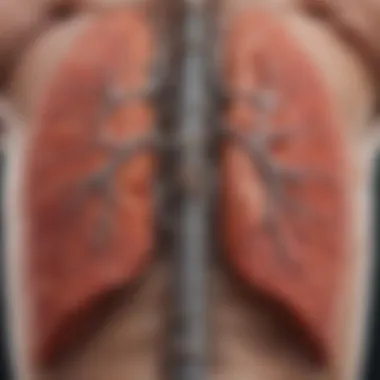
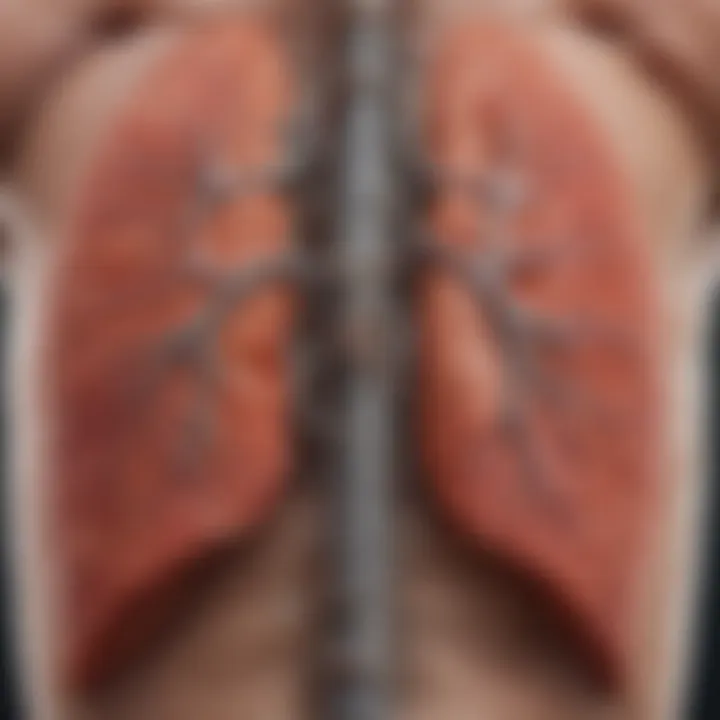
Intro
Emphysema and lung cancer are two significant health concerns that impact millions globally. Both conditions can severely affect respiratory function, and they share common risk factors, particularly smoking and exposure to environmental pollutants. Understanding the interplay between emphysema and lung cancer is crucial for improving early detection and treatment strategies. This article explores the fundamental concepts surrounding both diseases, examines recent research findings, and discusses how these conditions may overlap in their pathophysiological mechanisms.
Key Concepts and Terminology
Definition of Key Terms
- Emphysema - A form of chronic obstructive pulmonary disease (COPD) characterized by damage to the air sacs in the lungs. This damage leads to reduced elastic recoil and impaired gas exchange.
- Lung Cancer - A malignant growth within the lung, typically originating from the lining of the air passages. It can be classified into several types, with non-small cell lung cancer and small cell lung cancer being the most common.
- Chronic Obstructive Pulmonary Disease (COPD) - A group of lung diseases that block airflow and make it difficult to breathe. This includes emphysema and chronic bronchitis.
- Carcinogenesis - The process through which normal cells transform into cancer cells, involving genetic mutations and abnormal cell proliferation.
Concepts Explored in the Article
- Biological Mechanisms - The biological pathways linking emphysema and lung cancer, primarily through chronic inflammation and oxidative stress.
- Risk Factors - Analysis of lifestyle factors, especially tobacco use and air pollution, that contribute to the development of both conditions.
- Clinical Implications - The significance of understanding these connections for patient management, screening protocols, and public health strategies.
Findings and Discussion
Main Findings
Research indicates that individuals with emphysema are at a higher risk for developing lung cancer. A few crucial points to consider include:
- The chronic inflammation associated with emphysema may promote the development of cancerous cells in the lungs.
- Oxidative stress resulting from emphysema can lead to DNA damage, which is a key step towards carcinogenesis.
- Studies suggest that the presence of emphysema in lung cancer patients correlates with more aggressive tumor behaviors and poorer prognosis.
Potential Areas for Future Research
Additional studies are necessary to further elucidate the relationship between emphysema and lung cancer. Some areas warranting further investigation include:
- The role of genetic predisposition in the susceptibility to both diseases.
- Potential therapeutic targets that could mitigate the shared pathway of inflammation and oxidative damage.
- The impact of early detection strategies tailored for those with emphysema at risk of lung cancer.
Understanding the links between emphysema and lung cancer may help improve outcomes for patients by guiding clinical intervention and screening practices.
End
In summary, the connections between emphysema and lung cancer are complex and multifaceted. The overlapping risk factors underscore the need for heightened awareness and proactive measures in managing lung health. With advancements in research, healthcare professionals may be better equipped to address these challenges, improving patient outcomes and quality of life.
Understanding Emphysema
Understanding emphysema is a crucial step in exploring the connection between it and lung cancer. This reality stems from the complexity of chronic obstructive pulmonary disease (COPD) where emphysema plays a significant role. A deep comprehension of emphysema encompasses its definition, pathophysiology, symptoms, and the diagnostic approaches used. By grasping these dimensions, one begins to see why emphysema may not just be a standalone condition but a contributing factor to more severe diseases, including lung cancer. The relationship calls for continuous research, better clinical assessments, and enhanced patient education of the risks associated with these interrelated diseases.
Definition and Overview
Emphysema is a progressive lung disease marked by the destruction of alveoli, which are tiny air sacs in the lungs. The condition primarily results from long-term exposure to irritants like cigarette smoke and air pollution, leading to a decrease in the elasticity of lung tissue. This loss hinders the lungs' ability to expel air efficiently, causing breathlessness and overall reduced lung function. Individuals often mistake feeling winded as part of aging, but a timely diagnosis can make a tremendous difference in management and quality of life.
Pathophysiology of Emphysema
The pathophysiology of emphysema revolves around the imbalance between proteases and antiproteases. Enzymes known as proteases, which are essential for tissue remodeling, become overly active due to irritants, leading to the breakdown of elastin in the alveolar walls. This destruction results in larger air spaces and decreased surface area for gas exchange. As air gets trapped in these enlarged spaces, there is a consequent rise in intrathoracic pressure. This abnormal pressure impacts the bronchial passages and can lead to hyperinflation, further complicating airflow. Understanding this biological mechanism paves the way for targeted research and treatment options.
Symptoms and Diagnosis
Symptoms of emphysema often develop slowly and may include chronic cough, sputum production, and wheezing. A predominant sign is dyspnea, or shortness of breath, which typically worsens during physical activities. Early detection may be challenging because many attribute these symptoms to aging or general fatigue. To diagnose emphysema, physicians deploy various methods, including:
- Pulmonary function tests (PFTs) that measure lung capacity
- Chest X-rays to visualize the lungs
- CT scans for detailed imaging
An accurate diagnosis not only enables better management of emphysema but also informs the assessment of lung cancer risk, emphasizing the intricate interplay between these two diseases. Early intervention in emphysema can lead to an improved prognosis for lung cancer risk management.
The Basics of Lung Cancer
Understanding lung cancer is essential in the context of this article, especially as it relates to individuals who also suffer from emphysema. Lung cancer is not just one disease; it encompasses various types that have distinct characteristics and behaviors. Knowledge of these types assists in understanding treatment responses and prognosis. Importantly, this section addresses specific elements such as the nature of lung cancer, its prevalent risk factors, and common symptoms, providing a solid foundation for the subsequent analysis of its relationship with emphysema.
Definition and Types of Lung Cancer
Lung cancer primarily arises from the uncontrolled growth of abnormal cells in the lung tissues. It is categorized mainly into two types: non-small cell lung cancer (NSCLC) and small cell lung cancer (SCLC). NSCLC accounts for approximately 85% of lung cancer cases and includes subtypes like adenocarcinoma, squamous cell carcinoma, and large cell carcinoma. On the other hand, SCLC is less common but tends to spread more quickly and is often associated with a history of heavy smoking. Understanding these distinctions is critical for identifying treatment options and outcomes.
Risk Factors for Lung Cancer
Several risk factors contribute to the development of lung cancer, some of which overlap with those for emphysema.
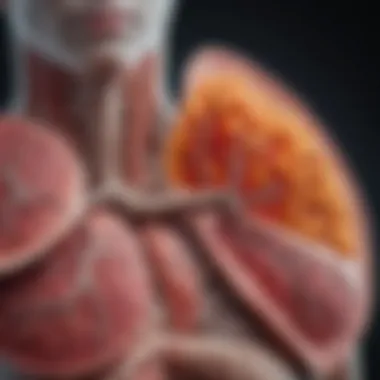
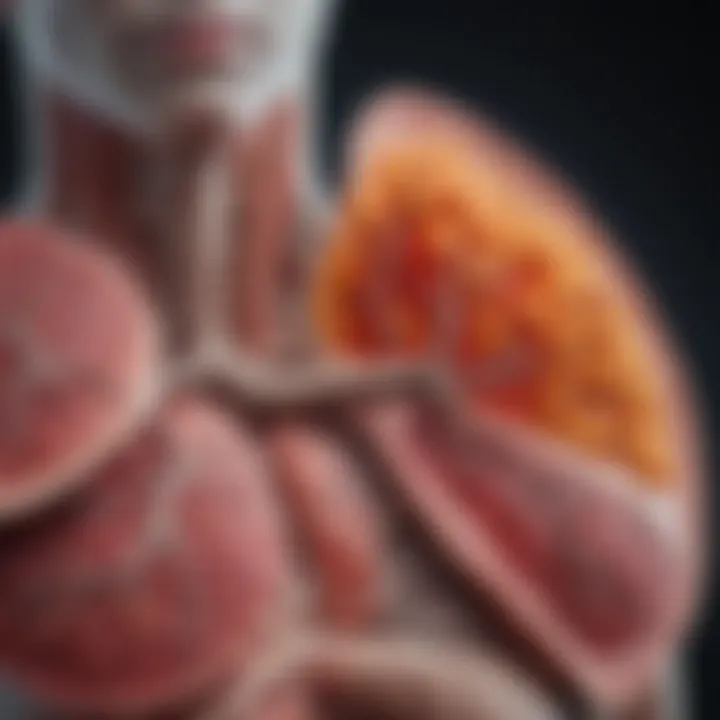
- Cigarette Smoking: This is the predominant risk factor. Prolonged exposure to tobacco smoke significantly increases the likelihood of lung cancer.
- Secondhand Smoke: Even non-smokers exposed to secondhand smoke are at increased risk.
- Environmental Factors: Prolonged exposure to pollutants or radon gas can contribute to lung damage and cancer risk.
- Genetic Predisposition: Family history and genetic mutations can also play a role.
Recognizing these factors can aid in understanding how lung cancer develops in patients who have existing lung conditions like emphysema.
Symptoms and Diagnosis
The symptoms associated with lung cancer can often mimic those of other respiratory conditions, including emphysema. This can sometimes lead to delays in diagnosis. Common symptoms include:
- Chronic cough: This may worsen over time.
- Chest pain: Often described as a dull ache.
- Unexplained weight loss: This symptom raises concern, especially when combined with other respiratory issues.
- Shortness of breath: Which can be confused with emphysema-related issues.
Diagnosis typically involves imaging tests such as X-rays and CT scans, followed by biopsy procedures to confirm cancer presence. Early detection is vital for better outcomes, underscoring the importance of awareness about lung cancer symptoms among those with emphysema.
Link Between Emphysema and Lung Cancer
The link between emphysema and lung cancer is a critical area of study in medical research. Emphysema is a form of chronic obstructive pulmonary disease (COPD) that leads to the destruction of the alveoli in the lungs. This loss of alveolar integrity has implications that extend beyond pulmonary function. Understanding this connection is essential not only for healthcare professionals but also for patients and policy makers. The interplay between these two conditions sheds light on the multifaceted nature of lung diseases and underlines the importance of addressing both emphysema and lung cancer in clinical practice.
Epidemiological Studies
Epidemiological studies provide valuable insights into the relationship between emphysema and lung cancer. Research has consistently shown that individuals with emphysema have a heightened risk of developing lung cancer compared to the general population. A meta-analysis indicated that patients suffering from COPD are over 2 times more likely to develop lung cancer. This correlation raises important questions about the common risk factors shared by both conditions, primarily smoking and environmental pollutants. In addition, population-based studies have revealed a connection between the severity of emphysema and the incidence of lung cancer. The more advanced the emphysema, the greater the likelihood of concomitant lung neoplasms. Therefore, understanding these epidemiological connections aids in screening and monitoring strategies for at-risk populations.
Biological Mechanisms
The biological mechanisms linking emphysema and lung cancer are complex and multifactorial. One key aspect is the shared pathways of inflammation and cellular damage. In emphysema, the destruction of lung tissue is often driven by an inflammatory response, primarily due to harmful agents like tobacco smoke. This chronic inflammation can lead to DNA damage and mutagenesis, thereby increasing the risk of malignancy. Furthermore, oxidative stress observed in emphysema may contribute to tumor progression through the activation of signaling pathways that promote cell proliferation and survival. Studies also highlight the role of growth factors, like epidermal growth factor receptor (EGFR), which are often upregulated in emphysematous tissue. Overall, these biological insights are crucial for developing targeted interventions and therapies.
Inflammation and Cancer Risk
Inflammation plays a pivotal role in the development of both emphysema and lung cancer. Chronic inflammation causes a cascade of events that can lead to tissue remodeling, a hallmark of both conditions. When lung tissue is repeatedly exposed to inflammatory mediators, it can promote a carcinogenic microenvironment. The presence of inflammatory cells like macrophages and neutrophils, which release reactive oxygen species and proteolytic enzymes, further exacerbates tissue damage. This environment not only supports tumor initiation but also enhances tumor growth and metastasis. It is important to recognize that the inflammatory response may vary depending on individual genetic predispositions and environmental exposures. The interaction between these factors adds an additional layer of complexity to understanding the mechanisms underlying lung cancer risk in patients with emphysema.
Understanding the link between emphysema and lung cancer informs clinical practices and preventive strategies.
Overall, unravelling the link between emphysema and lung cancer provides significant insights into the management of both conditions. This understanding can influence screening strategies, guide therapeutic approaches, and ultimately improve patient outcomes.
Cigarette Smoking and its Role
Cigarette smoking is the leading cause of lung diseases, including emphysema and lung cancer. Understanding its role is essential for comprehending the broader relationship between these two conditions. The act of smoking exposes the lungs to various harmful substances, which sets the stage for chronic diseases. The connection between smoking and lung health cannot be overstated, influencing not just the development of emphysema but also its progression and the likelihood of lung cancer.
Impact of Smoking on Lung Health
Smoking negatively impacts lung health in multiple ways. It causes inflammation, damages airway tissues, and reduces lung function. Over time, this results in chronic obstructive pulmonary disease (COPD), where emphysema is a predominant type. In emphysema, the air sacs (alveoli) in the lungs become damaged. When smoking occurs, irritants in the smoke lead to the destruction of these critical structures.
Some key points about the impact of smoking on lung health include:
- Decrease in Lung Elasticity: This makes it harder for the lungs to expand and contract effectively, causing shortness of breath and other complications.
- Increased Mucus Production: This often leads to chronic cough and respiratory infections.
- Vascular Changes: Smoking also causes changes in the blood vessels of the lungs, making circulation less efficient.
It is clear that the impact of smoking on lung health is dire and creates a hostile environment conducive to disease.
Smoking as a Common Risk Factor
When discussing risk factors for lung cancer, cigarette smoking emerges as the most significant. The majority of lung cancer cases are linked to tobacco use. Smokers are much more likely to develop lung cancer compared to non-smokers, even after considering other factors. Statistics show that approximately 85% of lung cancer cases occur among smokers or former smokers.
The common risk mechanisms involve:
- Carcinogen Exposure: Cigarette smoke contains numerous carcinogens, including benzene and formaldehyde, that damage the DNA within lung cells.
- Impaired Immune Response: Smoking weakens the immune system, making it harder for the body to fight off the cancerous cells that may develop.
- Synergistic Effects: Individuals with emphysema who smoke have an elevated risk of developing lung cancer compared to those with emphysema who do not smoke, illustrating a compounding effect.
Quitting Smoking: Effects on Risk
Quitting smoking has profound benefits for lung health and cancer risk. Evidence shows that stopping smoking can greatly reduce the risk of lung cancer over time. While former smokers remain at a higher risk than those who never smoked, the relative risk decreases substantially the longer an individual remains smoke-free.
Key effects of quitting smoking include:
- Improved Lung Function: Within weeks of quitting, lung function begins to improve. This can enhance the overall quality of life.
- Reduced Inflammation: The inflammatory processes triggered by smoking start to reverse, allowing lungs to heal.
- Lower Cancer Risk: Studies indicate that ten years after quitting, the risk of developing lung cancer can drop to about half that of a current smoker.
In summary, the role of cigarette smoking in relation to emphysema and lung cancer is a critical area of study. Understanding how smoking affects lung health and its position as a common risk factor can ultimately help in prevention and treatment strategies for both diseases.
Diagnosis and Screening Approaches


Diagnosis and screening are crucial elements in understanding the relationship between emphysema and lung cancer. Early and accurate diagnosis can significantly impact treatment success and patient outcomes. Since both conditions can share similar symptoms and risk factors, identifying them swiftly allows for better management strategies.
The aim of this section is to provide insights into various approaches used in diagnosing emphysema and lung cancer. This helps healthcare professionals distinguish between these diseases, ensuring proper interventions are employed early in the disease progression.
Imaging Techniques
Imaging techniques play a vital role in diagnosing emphysema and lung cancer. Common methods include:
- Chest X-rays: These provide fundamental insight into lung structure but may miss subtle changes typical of early-stage lung cancer.
- CT Scans: Computed tomography scans offer detailed images of the lungs. They help visualize emphysema and can identify tumors that may not be evident in X-rays.
- MRI: While less common for lung assessments, magnetic resonance imaging can sometimes provide additional information when assessing surrounding tissues.
These imaging methods help radiologists and clinicians observe the physical state of the lungs, which aids in making informed decisions on further diagnostic steps or treatments.
Biopsy Procedures
If imaging results suggest cancer or other abnormalities, biopsy procedures may be necessary. There are several techniques, including:
- Bronchoscopy: A thin tube is inserted through the airway, allowing direct visualization and sampling of suspicious tissue.
- Needle biopsy: A needle is guided into the lung to obtain tissue samples. This can be performed under imaging guidance.
- Surgical biopsy: In some cases, surgery may be required to collect a large tissue sample, particularly when other methods are inconclusive.
Biopsies provide definitive diagnosis by giving histological insight into the nature of a suspected tumor, determining whether it is cancerous or benign.
Screening Guidelines for High-Risk Groups
Specific guidelines exist for screening individuals at high risk for lung cancer, particularly those with a history of emphysema or significant smoking history. Key points include:
- Annual Low-Dose CT Scans: Recommended for adults aged 55-80 years with a heavy smoking history. This helps in detecting early-stage lung cancers when they are most treatable.
- Regular Assessments: Patients with emphysema should undergo regular check-ups, as they are more susceptible to lung cancer. Continuous monitoring helps identify any new symptoms or changes in health status.
- Risk Factor Management: Patients should be educated about controlling risk factors, including smoking cessation and managing lung health.
Each of these approaches enables healthcare providers to pinpoint issues early, paving the way for more effective treatment plans and improving prognosis for patients suffering from these conditions.
Preventive Strategies
Preventive strategies are critical in managing the risks associated with emphysema and lung cancer. The multifactorial nature of these diseases means that addressing various elements can substantially decrease morbidity and mortality. Effective strategies encompass lifestyle modifications, regular health screenings, and vaccinations, each playing an essential role in reducing the likelihood of disease progression.
Lifestyle Modifications
Lifestyle adaptations can significantly impact lung health and overall well-being for individuals with emphysema. Simple changes in daily habits can enhance lung function and quality of life. Some beneficial modifications include:
- Quitting Smoking: Cessation is the most important step to reduce the risk of both emphysema and lung cancer.
- Improving Diet: A balanced diet rich in antioxidants may help counteract oxidative stress in lungs.
- Regular Exercise: Engaging in physical activity enhances overall respiratory function and endurance.
- Avoiding Secondhand Smoke: Limiting exposure to smoke from other individuals is crucial.
These adjustments foster a healthier lifestyle. Furthermore, educational campaigns that emphasize the significance of these lifestyle changes can empower individuals to take charge of their health decisions.
Importance of Regular Health Screenings
Regular health screenings are paramount in the early detection of lung diseases. For individuals with emphysema, screening can uncover lung cancer at a treatable stage. Important screening tools include:
- Low-Dose Computed Tomography (LDCT): Recommended for high-risk individuals, this imaging technique allows for the early identification of lung nodules.
- Pulmonary Function Tests (PFTs): These tests help monitor lung function over time, identifying deterioration or changes that may indicate complications.
- Chest X-rays: Though not as definitive as LDCT, these images can still provide essential information about lung structure.
Early detection through routine screenings can dramatically improve prognosis and survival rates for lung cancer.
Encouraging patients to adhere to recommended screening schedules fosters a proactive approach to their health, ultimately aiding in better outcomes.
Vaccination and Its Role
Vaccination is often overlooked in lung health discussions, but it bears significant relevance for those with emphysema. Specific vaccinations can prevent respiratory infections that complicate existing lung conditions. Key vaccinations include:
- Influenza Vaccine: Annual vaccination can help prevent the flu, which can lead to pneumonia and exacerbate emphysema symptoms.
- Pneumococcal Vaccine: Aimed at preventing pneumococcal pneumonia, this vaccine can protect against serious lung infections.
- COVID-19 Vaccine: Given the elevated risks associated with respiratory illnesses, vaccination against COVID-19 is also advisable.
Integrating vaccine awareness into lung health management can reduce the incidence of infections that may trigger exacerbations in patients with emphysema.
Through these preventive strategies, individuals with emphysema can significantly decrease their risk of developing lung cancer. Adopting a holistic approach that incorporates lifestyle modifications, regular screenings, and vaccinations contributes not only to enhanced health outcomes but also to overall quality of life.
Treatment Options for Emphysema and Lung Cancer
The treatment of emphysema and lung cancer is a complex area requiring an individualized approach. Understanding these treatment options can provide significant insight into managing symptoms effectively, extending life expectancy, and improving quality of life. The interplay between these two conditions necessitates a careful review of strategies that address not only the diseases separately but also their combined impact on the patient's health.
Medications for Emphysema
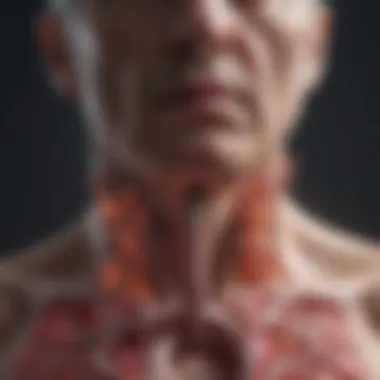
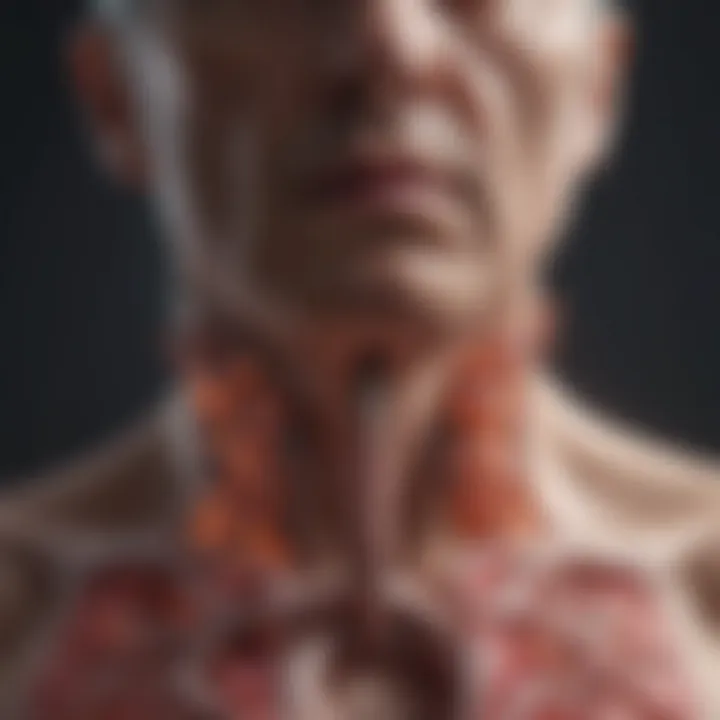
Medications play a crucial role in the management of emphysema. The primary goal is to relieve symptoms and enhance lung function. Bronchodilators, for instance, are often prescribed. They work by relaxing the muscles surrounding the airways, thus improving airflow and reducing breathlessness.
Corticosteroids can also be used, particularly to reduce inflammation within the lungs. They are effective in managing exacerbations of emphysema.
Additionally, phosphodiesterase-4 inhibitors, like Roflumilast, target inflammation and can decrease flare-ups.
Here are key medication types relevant for emphysema:
- Short-acting bronchodilators (e.g., Albuterol)
- Long-acting bronchodilators (e.g., Salmeterol)
- Corticosteroids (e.g., Prednisone)
- Phosphodiesterase-4 inhibitors (e.g., Roflumilast)
Patients need to work closely with healthcare providers to tailor these medications based on their individual responses and side effects.
Surgical Interventions for Lung Cancer
When it comes to lung cancer, surgical intervention is often the primary mode of treatment, especially for patients diagnosed with early-stage disease. The most common procedures include lobectomy, where a lobe of the lung is removed, and pneumonectomy, which involves removal of an entire lung.
Video-assisted thoracoscopic surgery is another minimally invasive option that can result in less pain and quicker recovery. In cases where tumors are not resectable, other treatments like radiation therapy and chemotherapy are often suggested.
Consider the following surgical interventions:
- Lobectomy
- Pneumonectomy
- Segmentectomy
- Wedge resection
Each surgical option is weighed against the patient's overall health, lung function, and specific tumor characteristics, making multidisciplinary evaluation crucial.
Combining Treatments: Challenges and Opportunities
The combined management of emphysema and lung cancer presents distinct challenges. Patients with emphysema may experience increased surgical risks and complications. Therefore, careful planning is necessary.
Every treatment approach must consider:
- Progression of Disease: Understanding how one condition affects the other.
- Patient's Respiratory Status: Assessing the patient's ability to tolerate surgery or aggressive treatment.
- Coordination: Ensuring cohesive strategies between pulmonologists, oncologists, and surgeons.
In many cases, palliative care becomes essential. This approach focuses on symptom management, especially for those unable to undergo aggressive therapy. Despite the challenges, interdisciplinary collaboration can lead to innovative treatment pathways, showcasing the resilience and adaptability required in patient care.
"Effective treatment for emphysema and lung cancer requires a nuanced understanding of both conditions, emphasizing the need for tailored approaches for each patient."
Both emphysema and lung cancer necessitate continuous research into emerging therapies. Future studies may yield options that synergize the effectiveness of treatments across different therapeutic fronts.
Future Research Directions
Future research into emphysema and lung cancer is essential due to the complex interplay between these conditions. An understanding of this relationship can lead to improved patient outcomes and therapeutic strategies. New knowledge can enhance early detection, treatment options, and preventive measures. Researchers must consider various facets, including biological markers, genetic factors, and innovative therapies, which hold the potential to revolutionize current approaches.
Identifying Biomarkers for Early Detection
Biomarkers are biological indicators that signal the presence of disease. In the context of emphysema and lung cancer, identifying specific biomarkers could greatly improve early detection. For instance, a study may focus on examining proteins, metabolites, or genetic markers that correlate with disease progression. Early identification of lung cancer is critical, as this typically leads to better prognoses. Studies like these can distinguish high-risk individuals through blood tests or imaging techniques, allowing for timely interventions.
Exploring Genetic Factors
Genetic predisposition is a crucial area for future research. Genetics can inform not only susceptibility to emphysema but also the likelihood of developing lung cancer. Investigating genes involved in inflammation, oxidative stress, and DNA repair mechanisms could unveil insights into why certain individuals with emphysema are at higher risk. Specific gene variations may help in predicting outcomes and tailoring prevention strategies. This research could pave the way for personalized medicine, where patient care is guided by genetic profiling.
Innovative Therapies and Clinical Trials
As understanding of the link between emphysema and lung cancer evolves, innovative therapies will likely emerge. Current treatments often focus on managing symptoms rather than addressing underlying causes. Future clinical trials should investigate targeted therapies that may halt or slow disease progression in emphysema patients susceptible to lung cancer. Techniques like gene therapy or the use of monoclonal antibodies represent cutting-edge approaches worth exploring. These avenues can shift the focus towards creating more effective treatments that address specific mechanisms involved in both conditions.
"Advancements in research regarding emphysema and lung cancer will greatly enhance patient care and quality of life."
Finale
In addressing the relationship between emphysema and lung cancer, it is crucial to underscore several important elements. First, recognizing the multifactorial risk associated with both conditions provides a clearer picture for medical practitioners and researchers alike. The interplay between chronic obstructive pulmonary disease (COPD) and lung cancer can lead to significant implications for patient treatment and management.
The article highlights how smoking, the foremost risk factor, acts not merely as a concurrent behavior but as a catalyst exacerbating both emphysema and lung cancer risks. This understanding reinforces the necessity for robust public health campaigns aimed at smoking cessation.
Another key takeaway is the importance of regular screenings for individuals diagnosed with emphysema. Early detection of lung cancer can dramatically improve prognosis, making it imperative for healthcare systems to implement strategies that promote routine assessments in at-risk populations.
Moreover, the emphasis on emerging biological mechanisms reminds us of the evolving landscape of medical research. This highlights the need for continued exploration of genetic and environmental factors in understanding how emphysema predisposes patients to cancer. By focusing on these areas, healthcare providers may develop targeted interventions in the future.
Finally, the article reflects on the relevance of integrated treatment approaches. By considering both conditions holistically, it becomes possible to tailor therapeutic strategies that address the complexities of patient health, improving overall outcomes in affected individuals.
"Understanding the interconnectedness of diseases like emphysema and lung cancer paves the way for enhanced patient care and preventive measures."
In summary, the conclusion serves to reinforce that the issues surrounding emphysema and lung cancer are not merely academic; they have substantial real-world implications for prevention, diagnosis, and treatment strategies. As research continues to advance, the hope remains to better our understanding and improve lives afflicted by these serious health challenges.







